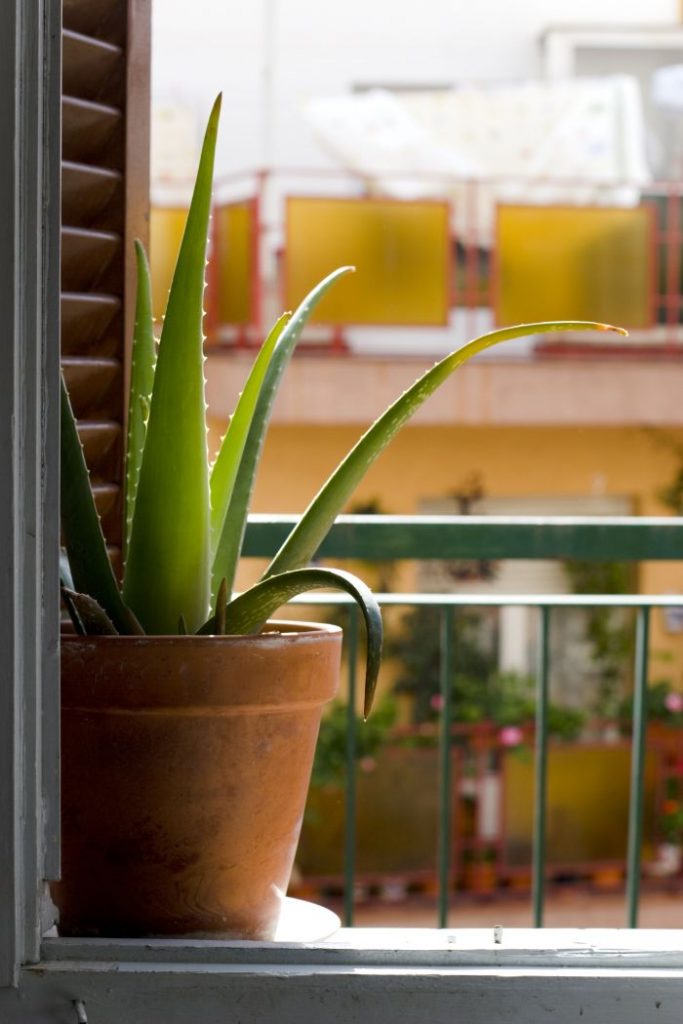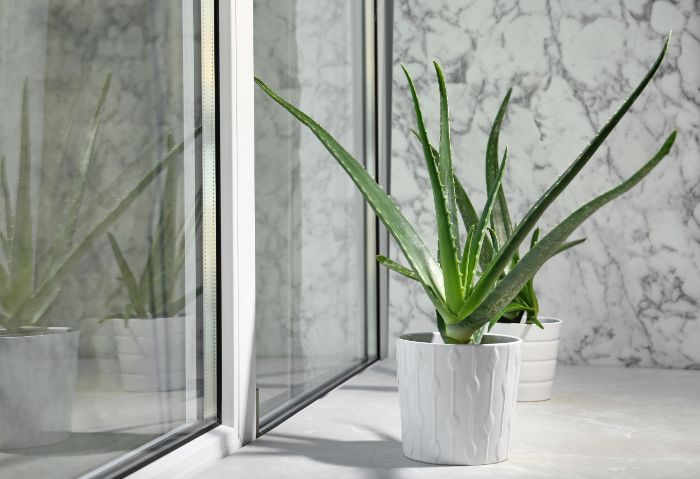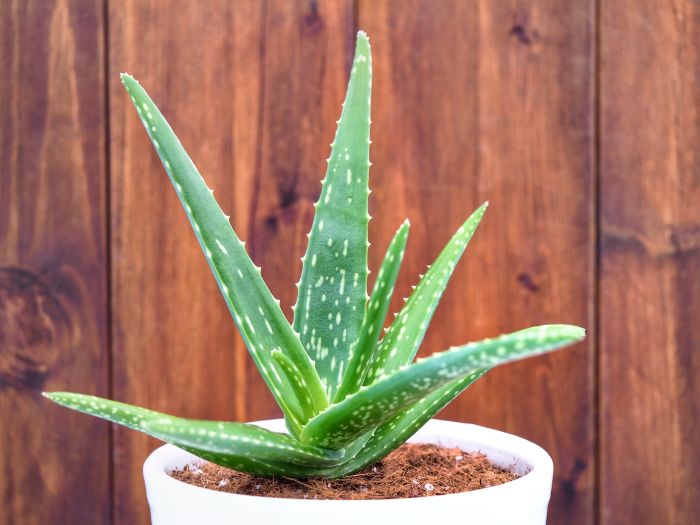Aloe Vera is a popular houseplant because it’s hardy, tolerant, and easy to care for, and its unique shape and texture make for attractive potted plants. Plus, it’s great to have on hand because you can use Aloe Vera gel for skin healing and moisturizing. If you just got a new, young Aloe Vera houseplant, you’ll naturally be wondering excitedly how long it will take to grow.
How fast does Aloe Vera grow? Aloe Vera plants grown indoors will take 3-4 years to grow from a pup to a full-grown plant with mature leaves of around 8-10 inches (20-25 cm) in length. To encourage fast growth, make preparations before planting, ensure you’re providing optimal care, and boost the growth rate with fertilizer.
Read on to learn more about the growth rate of Aloe Vera and find out what you can do ahead of planting to foster rapid growth as well as how to provide the best care for your Aloe Vera houseplant to encourage strong and healthy plant growth, along with some additional steps you can take to encourage speedier growth.
Aloe Vera Is A “Fast-Growing” Succulent
Aloe Vera is among the faster-growing types of succulent plants – but with succulents being a group of plants that grow quite slowly in comparison to other kinds of plants, that means Aloe Vera grows at a slower rate than all other plants besides slower-growing succulents like cacti.
Being a slow grower allows the Aloe Vera to use fewer resources. It’s one of the characteristics, along with water-storing tissues, root systems that grow out horizontally to search for water near the soil surface, and other features that these plants have adopted to help them survive the harsh arid climates where they grow.
Aloe Vera Growth Rate
The precise growth rate of an Aloe Vera plant depends on its environmental conditions as well as on the growth stage and health of the plant. But in general, you should expect to be able to observe some visible indications of growth in your plant over the course of one month or less, with the plant producing a new leaf from its central rosette once a month or so. Significant increases in size should take place in a period of about four months.
It will take several years for an indoor Aloe Vera to grow from a pup to a full-grown plant with leaves at its base that are around 8-10 inches (20-25 cm) in length. And given the right growing conditions and care, it may continue to grow very slowly after that until it reaches a maximum size of about 18 inches (46 cm) in height and width.
Factors That Influence Aloe Vera Growth Speed
There are a number of factors that can influence the speed at which a particular Aloe Vera plant grows.
Growing Conditions
Growing conditions are the biggest factors affecting a plant’s health and ability to produce new growth. By doing your best to provide the optimal growing conditions for your Aloe Vera houseplant, you will ensure that you’re meeting the specific needs of this type of plant so it will have the energy for vigorous growth.
Here is a brief summary of Aloe Vera’s preferred growing conditions:
- Growing container: Clay pot with drainage holes that provides plenty of room for roots to spread out
- Potting soil: Well-draining potting mixture that contains some course sand or perlite
- Light: Direct sunlight or artificial grow lights
- Temperature: 55-80 F (13-27 C)
- Watering: Water thoroughly and allow the excess water to drain, then allow soil to dry out before watering again

Growing Aloe Vera Plants Inside Vs. Outside
Another major factor in the growth rate of Aloe Vera is whether the plant is indoors or outdoors. Aloe Vera plants located indoors grow more slowly than plants that are growing outside.
Growth Stage
Like other plants, Aloe Vera goes through an active growth stage each year during the spring and summer months then experiences a dormant or resting period in the winter, when it grows very little or not at all.
Plant Health
Healthy Aloe Vera plants grow more rapidly than plants that are struggling with issues that are weakening it such as pests, diseases, and adverse growing conditions.
Preparing A New Aloe Vera Plant For Rapid Growth
There are a few things you can do to prepare a new Aloe Vera houseplant to grow more rapidly from the outset:
Potting Soil
Aloe Vera needs a well-draining potting soil to ensure that its roots don’t suffer from too much moisture. You can use a commercial succulent or cactus potting mixture or you can make your own.
Be sure to include some coarse sand or perlite to reduce the risk of overwatering, which will cause root rot and disease that will slow or halt the plant’s growth.
Growing Container
Choosing the right kind of growing container is also a good way to help your Aloe Vera grow more quickly. A clay or terracotta pot will help the soil dry out thoroughly between waterings.
Always make sure the container has drainage holes. The size of the pot is important too: Place your Aloe Vera in a container that’s about three times the size of the plant’s root ball.
Bury Banana Peels
One great, very easy trick to give newly potted Aloe Vera plants an extra boost is to use banana peels. Simply burying whole or chopped peels in the potting mixture before you pot your Aloe Vera will slowly release potassium into the soil, which builds plant strength for resistance against pests and disease as well as sustaining efficient water and nutrient use.
Encourage Root Growth
Another trick that will help ensure faster growth is to dust the plant stem or any existing roots with a rooting hormone powder to encourage your Aloe Vera to put out new roots.
Another trick for encouraging root growth is to avoid watering newly potted plants (after thoroughly watering when potting) for 2-3 weeks, forcing the roots to spread out in search of water and become established more quickly.

Take Proper Care Of Your Aloe Vera Houseplant To Encourage Rapid Growth
Making sure your plant is healthy is the easiest way to help it grow faster. Although Aloe Vera houseplants are quite easy to take care of, don’t neglect to pay attention to the specific needs of this type of plant.
Here are the main Aloe Vera care issues to address to encourage the most rapid, healthy growth:
- Repotting: Always make sure your Aloe Vera’s container is big enough to allow room for further growth. This way, you won’t have to repot as often, which stresses the plant and impedes growth. As mentioned before, choose a pot that’s about three times the size of the plant’s root ball. Also, it’s best to use a pot that’s wide rather than deeper to allow the roots to spread out.
- Light: Aloe Vera needs lots of light, so place your plant within 3 feet of a sunny window where it will receive at least 6 hours of direct light per day. Or, provide about 16 hours of bright artificial lighting per day with full-spectrum grow lights. Just make sure the light is bright, but not too harsh, as too much light will blanch the leaves and stunt plant growth. Also, make sure the lighting doesn’t make the plant too hot. And rotate the plant once or twice a week so all parts of the plant are exposed to the light.
- Temperature: Typical indoor temperatures of 55-80 F (13-27 C) are ideal for Aloe Vera plants, so all you have to do is make sure your plant isn’t in a location in your home that is hotter or colder than temperatures that are comfortable for you.
- Watering: Proper watering is always essential for vigorous houseplant growth. Aloe Vera plants are easy to water because you simply water the potting soil thoroughly, allow the excess water to drain away, and then leave the plant be until the soil has completely dried out before watering again. With Aloe Vera, less watering is always better than watering too often, since these plants are built to withstand drought.
Fertilize Your Aloe Vera Houseplant To Enhance Growth
Although Aloe Vera plants are light feeders that don’t typically need fertilizer to sustain healthy growth, fertilizing will give the plant an extra boost of energy for faster growth. Choose a low-nitrogen liquid fertilizer that’s formulated specifically for succulents.
Fertilize twice a month during the plant’s active growing season, April-September, diluting the fertilizer by at least half. Do not fertilize during the wintertime, when the plant is resting.
To prevent chemical burns, it’s best to apply the fertilizer after you’ve irrigated and allowed the excess water to drain out of the soil.
And remember the banana peel trick? You can also soak chopped banana peels in water for two days and then pour the resulting tea into the potting soil to fortify the plant and enhance rapid growth.
See my article about fertilizing houseplants naturally for some more tips about using natural products to give your indoor plants a growth boost.
Don’t Allow Your Potted Aloe Vera To Become Overcrowded
Eventually, your Aloe Vera may produce offsets, or pups, which are baby plants that grow from the sides of the mother plant. These pups should be removed – you can repot them to start whole new plants.
Or perhaps you have an Aloe Vera plant that’s packed together tightly in an attractive succulent arrangement. The point here is that crowding causes competition for water and nutrients and can also encourage mold and insect infestations, all of which will slow the plant’s growth rate.

